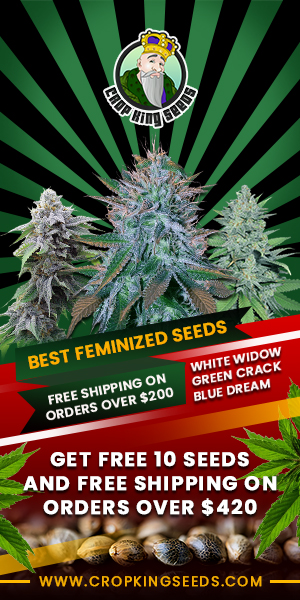Can You Veg and Flower in the Same Room?
When you grow marijuana indoors, most people have limited space available. It’s not only the lack of space, but also the desire for privacy. Even though it’s legal to grow in Canada and some US states, growing marijuana ‘in secret’ is a good practice. So, I get the need to grow weed plants at home in various stages in the same space.
The only way to grow multiple marijuana plants that are in the veg and flower stage in the same room is to have a divider that can block all the light from each grow area. You can’t grow weed both in the veg and flower stages in the same space under the same conditions. Vegetative and flowering stage growing have different light requirements.
The truth of the matter is when marijuana is in the veg vs the flower stages, the amount of time the grow lights are turned on will differ. The average time per day to have the lights on for veg is 18 hours and 12 hours per day for the flowering stage. Your weed plants have different growing needs for lighting and fertilizing, depending on what stage the plants are in.
In this article, I’ll talk about the different lighting requirements based for each growing stage and touch on fertilizers a bit as well. I’ll also discuss what happens when lighting from one stage ‘spills over’ to the other stage and how it can affect with your plant’s growth.
Okay, let’s get to it…
What is the Main Reason for Not Vegging and Flowering in the Same Room?
There are a couple of important reasons for not having weed plants that are in the veg stage and the flowering stage growing in the same room under the same lighting conditions.
- The amount of time your plants receive light and the light spectrum matter a great deal to either growth stage.
- The light spectrum you provide your weed plants with via the grow lights affects how the plants grow. For grow lights, the kelvin of the light being used is extremely important. What’s good to know is the higher the kelvin, the better it is for the veg stage. The lower the kelvin, the better for the flowering stages.
- The different light ranges (or kelvin) run on a scale in the ranges of 1000 to 10,000. A good kelvin range for the veg stage is around 6500 and the flowering stage can be somewhere around 2700.
- These different kelvin ranges mimic the sun in the summer and the fall. Around 6500 kelvin is good for the beginning stages of your weed plants because it’s closest to sunlight strength in the summer. On the other hand, the kelvin factor best for flowering is somewhere around 2700 because it closely resembles the sun’s light in the fall as the earth starts to tilt away from it. The fall is when the buds start, which is the flowering stage.
Luckily for us, marijuana growers that don’t fully grasp the whole kelvin scale (or don’t care to learn much about it) will be happy to know that most, if not all, grow lights made for marijuana will have lighting for both the veg and flowering stage built right in. So, it’s as easy as clicking a button that literally says either veg or flower.
- The amount of daylight your plants receive can affect the growth of the buds, especially when the plant is already in the flowering stage. If your plants are in flower and they start to receive more light than required, the buds can become hermaphroditic. Having a plant go ‘hermie’ on you is not the end of the world, however. When a plant turns into a hermaphrodite, seeds grow in the bud. This affects the quality of the buds when being smoked.
- This can also go the opposite way for a plant that is still in the veg stage and is not quite ready to be flipped to the flowering stage. If the amount of daytime light is reduced enough, it can cause the plants to start into the flowering stage. If this happens too soon, the plant won’t produce the buds you want it to.
Maybe this changes for auto flowering plants but even with autos, having the incorrect light spectrum will affect the yield you can expect.
Can You Veg Outdoors and Flower Indoors?
Starting weed plants outside in the spring or summer and bringing them indoors in the fall is an excellent idea, especially for growers in regions where the fall chill and possibility of frost could destroy your plants.
One word of caution, however, is to make sure you don’t bring in any pests on the plants, especially if they are going in a grow room with other plants that were already being grown indoors.
Spraying the plants and soil with a non-chemical bug spray will help to get rid of any outdoor critters that might ‘hitch a ride’ on the plants indoors.

How and When to Switch from Veg to Bloom
It’s probably worth touching on the subject of how to switch your plants from veg to bloom (flower).
The whole process of getting your weed plants to enter the flowering stage revolves solely around how long the lights are left on for.
It is as simple as changing the lighting from 18 hours on to only 12 hours on. After a couple weeks, you should start to notice buds forming on the plants.
The right time to flip the lights from veg to flower will differ from plant strain to grower. A couple of things for you to consider would be the desired end height of the plant and age of the plant.
- If you’re growing in a grow tent, the height of the weed plants matter. If you outgrow the tent, then what? My general rule-of-thumb for what height to flip the lights over to flower is when the plant is approximately between 1/3 and 1/2 of the desired end height of the plant.
- This might seem like it’s too soon, but after you grow a weed plant, you’ll see that in the flowering stage, the plant grows quite a bit.
- If you want a general time frame and are growing indoors with grow lights and fertilizer, flipping from veg to flower should happen somewhere between 4 and 6 weeks of your seeds sprouting.
Between these two things to watch out for, you should be able to identify when it’s the right time for you to flip your grow lights to flower.
It’s really that simple.
Conclusion
Just to conclude, remember that having the proper type of lighting on your weed plants is necessary for them to grow the way they are supposed to.
Higher kelvin lighting in the 6500 range for the beginning or veg stage and lower kelvin lighting for the budding or flowering stage is recommended.
The timing the lights are on also affects how the plants grow. The common rule-of-thumb for veg stage is 18 hours of light followed by 6 hours of darkness. Then for flower lighting, dial it back to 12 hours on and 12 hours off.
Hopefully, this article’s been of help to you. Thanks for reading. Good luck with your grow.
Related Posts
Can You Switch from Flowering to Veg?









